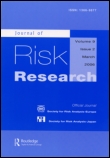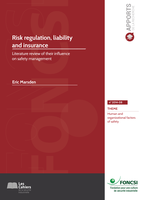Liability and insurance and their influence on safety management
There is increasing societal concern about industrial activities which pose risks to health, safety, property, and the natural and human environments, and about amplification of these risks by natural hazards and terrorism. Major accidents and other harmful incidents arising from industrial activities and products fuel this concern (such as oil spills, pipeline and chemical facility explosions, transport accidents, toxic products, malfunctioning medical implants, contaminated foods). These events indicate the continuing need to improve the management approaches taken by companies to ensure safety during the design and marketing of products and the planning and operation of company facilities and projects.
Much attention is therefore being given to developing government regulations and industry standards and certification programs which can bring about improvements in safety management and more effective means of preventing harms and preparing for emergencies. However, other forces at work in society also influence company conduct of safety management, especially laws which impose liability for causing harms and losses after their occurrence, and decision-making in the insurance and reinsurance business sectors on providing companies with coverage for harms and losses caused by their operations and products. These other forces function independently of regulation and their influence on company approaches to safety, although reputed to be substantial and either helpful or detrimental, remains relatively unexplored.
The workshop serves as a forum for presentations and discussion based on knowledge gained from working experience and/or empirical research with regard to the influence of liability law and insurance/reinsurance on safety management of existing types of industrial operations and products. In addition, the meeting is also open to informed presentations and discussion of such influence on safety management of new types of products and industrial activities, and industrial application of new technologies (e.g. robotics, automation, nanotechnology, genetic engineering, carbon sequestration).
Liability law
The term liability law is broadly used here to refer to legal doctrines and principles which provide the framework and criteria for courts or administrative entities to make determinations of individual or organizational responsibility for harms and impose the obligation to compensate for such harms. Examples include:
-
Tort liability law created by the courts in common law countries (UK, USA, etc.) and set forth in EU directives and the civil codes of EU member countries;
-
Legislation, decrees, and regulations which impose civil and criminal penalties when their requirements are violated;
-
Compensation systems for special categories of injury and damage.
Insurance and reinsurance
Firms in these business sectors determine the conditions and extent to which they will bear the potential financial consequences of specified types of harms that may be caused by a company’s product or operation, and the pricing for this transference of economic risk. In addition, they may assume responsibilities to defend such companies and settle claims by injured parties. They may also provide safety management expertise and oversight to their client companies. However, national legislation or international convention may limit the liability of operators, as in the case of the nuclear power industry, leaving governments as the ultimate insurers.
Safety management

The term safety management is used here to encompass company or industrial sector practices related to safety in the design or marketing of products or in the planning or operation of industrial facilities, projects or other activities. Safety management starts with ensuring compliance with government regulations, adhering to a company’s code of conduct, and adopting the voluntary standards and recommended practices of the relevant industrial sector. It may then be enhanced by voluntarily taking further steps to improve safety based on experience, ethics, stakeholder demands, newly-recognized technical uncertainties, or other considerations including residual (non-regulated) risks and their potential for incurring liability. Taking such further steps to improve safety or to establish a safety culture within a company often requires justification based on cost-benefit analysis. Also it should be noted that the trend towards replacing prescriptive and highly-detailed government regulation with broadly-defined performance-based regulation or other flexible types of regulation creates new uncertainties for safety management about what needs to be done for compliance, and raises the issue of whether the company’s traditional defense against liability claims of showing compliance with government standards will continue to be as effective as in the past. It also causes concern that this newly acquired freedom may lead to undesired weakening of safety management.
Workshop organizers
- Michael Baram, Boston University Law School
- Gilles Motet, Foundation for an Industrial Safety Culture
- Ernst Zirngast, Swiss Reinsurance Company
- Stefan Mueller, Technical University Berlin
Outputs
A number of papers presented during the workshop were published in 2014 in a special issue of the Journal of Risk Research (volume 17, issue 6, 2014). An overview of the special issue is provided in the editorial:

A survey of the literature related to these topics was published by FonCSI in its collection of documents Les Cahiers de la Sécurité Industrielle in 2014. The document, which can be freely downloaded in PDF and EPUB formats, provides an overview of the academic and professional literature on the links between safety regulation, liability regimes and insurance and their impact on safety management.
Image credit: hillman54

